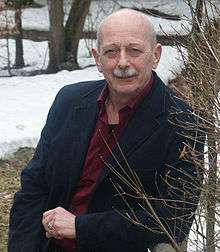Royston Maldoom
Royston Maldoom, OBE (born 1943 in Harrow, London) is a British choreographer whose works, including Adagietto and Ursprung, have been performed for various dance companies, such as The Jefferson Dancers and Dance Theatre of Harlem.

Dance, Choreography and Community Dance.
Royston Maldoom’s career as a choreographer began in 1972 when he received a major Gulbenkian Foundation award for his work in a Royal Ballet workshop, he had previously been studying dance with Hilde Holger. Since then he has created works for companies in Britain and abroad, including Dance Theatre of Harlem (New York), 'Atlanta Contemporary Dance Company' (Georgia USA), 'Ballet San Marcos' (Peru), 'Northern Ballet Theatre' (Manchester UK), 'EMMA Dance Company' (Leicestershire UK), Scottish Ballet (Glasgow UK) for whom, in collaboration with Graham Bowers, he created 'Ursprung'.
In 1975 his small group, 'Mercury Dance Company', won first prize at the 7th International Choreographic Competition at Bagnolet in Paris, and was subsequently awarded the 'Foundation of France' prize for choreographer and company.
Maldoom was appointed 'Dance Artist in Residence' jointly by Fife and Tayside Regional Councils in January 1981. The year’s residency with financial support from the Scottish Arts Council, was the first of its kind to cover an area rather than a single institution, and through his unique and unconventional approach to dance successfully encouraged participation and interest in dance within communities, with performance workshops and classes, on a scale not seen before.
He was responsible with others in forming Dundee Repertory Dance Theatre and in his role as Artistic Director, established a solid, successful and ongoing base for professional contemporary dance in Scotland. He also maintained his commitment to community dance by setting up annual summer projects, where people within the community regardless of age and experience, could participate in a work that culminated in a performance to commissioned music and stage design at a professional venue. One such work was ‘Bivouac’ where Gordon McPherson wrote the musical score and Graham Bowers designed the costumes and stage set. The company was renamed several years later and adopted the name Scottish Dance Theatre, after the closure of Peter Royston’s original company of the same name.
Dance United
In 1996, Dance United founders Andrew Coggins, Mags Byrne and Royston Maldoom, together with the Ethiopian Gemini Trust, created a unique dance project in Addis Ababa with street children which led to the foundation of the Adugna Community Dance Theatre Company. In 2000, Dance United was officially established.
Trained intensively over many years in Addis Ababa by dance artists from all over the world, eighteen young Ethiopian dancers graduated in 2002 with accreditation from Middlesex University (UK). In 2004, Junaid Jemal Sendi won the international Rolex Young Choreographer award, the first ever African artist to win this prestigious accolade. Junaid and fellow Adugna dancer, Addisu Demissie, also played key roles in Dance United’s DESTINO at Sadler’s Wells in 2009.
The following is taken from the website of Rhythm Is It!
…..Following a period as Dance Research Officer for Stirling District Council he moved to London and began to work more internationally in South Africa, Zimbabwe, Oregon (USA), Lithuania during the independence struggle and Croatia/Bosnia during the Balkan conflict.
Royston has worked with former street children in Ethiopia, marginalised children in Peru, Catholic and Protestant youth in Northern Ireland, male and female prison inmates, children and adults with Learning Difficulties, young people excluded from mainstream education, and children -in-exile as well as in many primary and secondary schools, and vocational dance colleges.
Royston has worked extensively in Germany as choreographer of the European youth dance festival in Duisburg, The Britisch-Deutscher Jugendtanzaustausch in Berlin in 1989 to 1991, visiting choreographer to the Hochschule für darstellende Kunst Ballet School, Frankfurt, and most recently with the Berliner Philharmoniker.
The Berlin project was the most recent in a series of works for orchestra that included the London Symphony Orchestra, Ulster Orchestra, Scottish Chamber and Symphony Orchestras, Natal Symphony Orchestra and several chamber orchestras and choirs. His The Rite of Spring has been performed in Addis Ababa, Duisburg, Berlin (1990 and 2003), Lima, Belfast, London, Vilnius, Glasgow and in many schools and communities in the UK, as well as in Auckland, New Zealand in 2011 with the Auckland Philharmonia Orchestra and 170 hitherto untrained dancers from 6 Auckland schools. He also came to NYC in 2007 and worked with four inner city schools to reproduce the Rite of Spring dance with the Berlin Philharmonic. (Twelve students from PS 161 in West Harlem as well as two Harlem high schools & six students from an elementary school were the dance performers.)[1]
References
- Atamian, Christopher (November 11, 2007). "'Rite of Spring' as Rite of Passage" – via NYTimes.com.